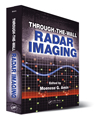
Through-the-Wall Radar Imaging
Moeness G. Amin, Villanova University, Editor.
Through-the-wall radar imaging allows police, fire and rescue personnel, first responders, and defense/special forces to detect, identify, classify, and track the whereabouts of people and moving objects within buildings, tunnels, etc. Through-the-Wall Radar Imaging examines this technology from the algorithmic, modeling, experimentation and system design perspectives. It begins with coverage of the electromagnetic properties of walls and building materials, and discusses techniques in the design of antenna elements and array configurations, beamforming concepts and issues, and the use of antenna array with collocated and distributed apertures.
The chapters in the book discuss wall attenuation and dispersion effects in view of angles of incidence and antenna polarization and covers wideband, low profile and printed antennas, as well as planar/conformal UWB antennas. It also emphasizes the PSF characteristics that result from the use of UWB waveforms and examines the design of emerging waveforms to optimize target detection by increasing target-to-noise and clutter ratio with special emphasis of matched illumination-based signature exploitation techniques. It studies EM wave propagation through walls and shows the dispersion and blurring effects on behind-the-wall target images.
It also covers several suitable waveforms, inverse scattering approaches and the relevance of physical-based model approaches in through-the-wall radar. Theoretical and experimental research in 3D building tomography using microwave remote sensing, high frequency asymptotic modeling methods, synthetic aperture radar (SAR) techniques, impulse radars, airborne radar imaging of multi-floor buildings strategies for target detection and detection of concealed targets are discussed. The book concludes with a section on how the Doppler principle can be used to measure motion at a very fine level of detail.
Through-the-Wall Radar Imaging covers the subject in detail and stresses the multidisciplinary approach needed to design such radars. It is a good book for anyone looking to gain a deep understanding of the subject. Also, a section of colored images and diagrams of radar scans and other images is a nice addition that is not seen in many books.
To order this book, contact:
CRC Press,
6000 broken Sound Parkway NW,
Suite 300
Boca Raton, FL 33487 (800) 272-7737;
Pages: 550, $149
ISBN: 978-1-439-81476-5
